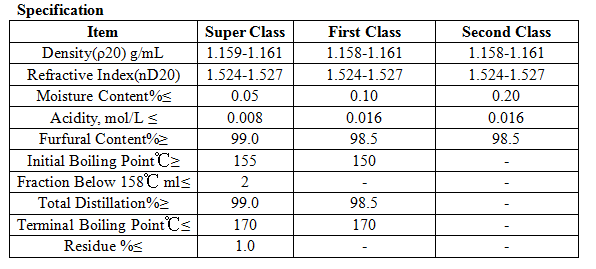Nature:
Character
Furfural is made from agricultural materials by means of hydrolysis. It is a colorless or yellow oily liquid with an almond odor. Upon exposure to air it turns to black or dark brown. The relative density is 1.1589. Boiling point is 161.7℃. It is slightly soluble in water and soluble in hot water, alcohol, ether benzene. The kindling point of furfural achieve 393℃ and explosion limit is between 2.1% and 19.2%.
Standard
Chemical constituent and physical properties are all according with national standard (GB/T 1926.1-2009).
Methods of analysis.Details of test methods can be supplied on request.
Packing: In 240kg steel drum or as clients’ request.
Storage and Operation
It should be stored in cool, ventilating and dry places and separated from Inflammable goods and food.
Operator must wear protective clothing with glasses and rubber gloves, preventing to contact with eyes and skin.
Protection
Poisonous, middle grade.
Routes of exposure: inhalation, eating, skin contact.
Strong irritative in vapour.
Harmful gas is decomposed from furfural upon 300℃ high temperature.
First aid
Skin contact: Take off the contaminated clothing, thoroughly rinse the skin with soapy water and then clean water.
Eye contact: Tip the eyelid and thoroughly rinse with plenty of flowing water or normal saline at least 10 minutes.
Inhalation: Out of the scene immediately and remove to fresh air quickly. Keep the unobstructed of respiratory tract. If breathing is difficult, give oxygen. If not breathing, give artificial respiration and get medical attention.
Ingestion: Once swallowed, drink enough water first and then induce vomiting, go for doctor.
Disposal of leakage
The people in the leakage of contaminated areas must be withdrawn to safe area and quarantined. Cut off the fire source and dilute with water or bury by soil.
1.Extracting agent for petroleum
2.Used for refining animal oil and plant oil.
3.Additive of engine fuel.
4.Improving the qualities of diesel oil.
5.Producing the lubricating oil.
6.The production of plastic and plastic fibre.
7.Material for preservative, rust remover and antifreeze.
8.The production of medicine.
9.Raw material for manufacturing nylon 66.

